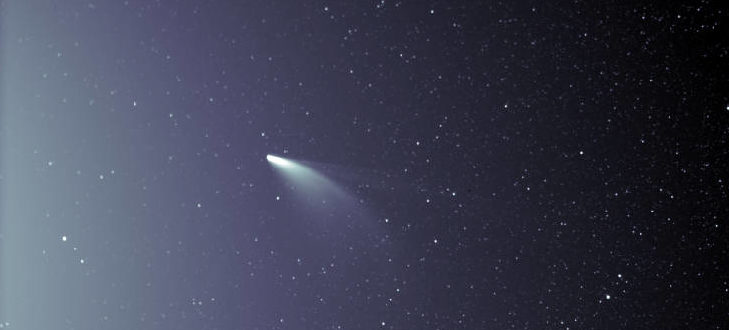The State We're In
Comet Neowise illustrates importance of dark skies
Since the earliest days of human civilization, the night sky has been a source of fascination and mystery. Ancient star-gazers saw human and animal shapes in clusters of stars, and invented elaborate mythologies. Trying to understand the night sky inspired science, religion, philosophy, mathematics, art and literature.
One of the most awe-inspiring sights is a comet, which often appears literally “out of the blue” before disappearing in a matter of days or weeks.
Ancient Greeks and Romans believed the mysterious appearance of comets signaled either good or bad news ahead, including the birth of a great leader. Some speculate that the Magi followed a comet, not a guiding star, to Bethlehem to see the newborn baby Jesus.
This month, for the first time in more than 20 years, a bright comet is visible from the Northern Hemisphere. This comet -named Neowise after its discoverer, NASA’s Near-Earth Object Wide-field Infrared Survey Explorer – is now visible after sunset. It has already passed its closest point to the sun and will pass closest to Earth on July 22.
Comets have been described by modern astronomers as “dirty snowballs” that orbit the sun. They’re made of ices mixed with dust dating from the formation of our solar system. They have an icy center, known as the nucleus, and a tail, or coma, made of gases and dust.
Unlike the wake of a boat, the tail of a comet does not trail behind the comet’s path. The tail is produced by solar wind, moving out from the sun and carrying evaporated gases and particulate matter from the comet’s nucleus away from the sun. So a comet’s tail points directly away from the sun.
How can you see Comet Neowise?
Here’s some advice from New Jersey Conservation Foundation’s staff biologist Dr. Emile DeVito, an astronomy buff since he was a kid:
- Pick a location as dark as possible, with a good view toward the horizon to the north and northwest. Try to find a place where light pollution from a large town is not directly to the north or northwest of your location. Use binoculars to get the best view.
- Use binoculars or a telescope to get the best possible view. First focus on bright stars directly overhead, to be sure that stars appear as pinpricks of light, then scan for the comet. Look north-northwest low toward the horizon, below and to the right of the cup of Big Dipper.
- In places with light pollution, you may have to wait until the sky gets completely dark before you can see the comet.
- If you cannot find dark skies or a clear view of the horizon, consider going to a public park or open space, or even a quiet rural roadside.
- Even if you can’t get to a dark, rural area, you may still be able to view the comet if the sky is clear and doesn’t have too much haze from humidity. Try accessible rooftops or upper floors of tall buildings in built-up urban and suburban areas, or from public sidewalks adjacent to large open ball fields or recreation areas that allow for low views of the north-northwest horizon. Or look for areas where bright streetlights or floodlights are least prevalent in the direction where you are looking for the comet.
Because New Jersey is the nation’s most urbanized state, there are many places where Comet Neowise won’t be visible in its full glory due to light pollution.
This underscores another benefit of permanently preserved land: dark skies. Dark skies are becoming rare as suburbanization and light pollution creep across the landscape. Thankfully, New Jersey continues to lead the nation in land preservation and this state we’re in has some incredible dark sky regions, including the Pine Barrens, the hilly northwestern counties, and the agricultural belt in South Jersey near the Delaware Bay.
The International Dark-Sky Association believes a dark night sky is a part of our “common heritage” and is in danger of being missed by younger generations. Millions of children across the globe, for example, may never experience clear, spectacular views of our galaxy, the Milky Way.
But the problem is deeper. A growing body of research suggests that the loss of dark skies can impact human health and the rhythms of the natural world.
For nocturnal animals, artificial light at night can disrupt feeding and mating patterns. Light pollution can also have negative impacts on migrating birds, sea turtle hatchlings, and insects. For humans, excessive exposure to artificial light at night – especially blue light – has been linked to increased risks for obesity, depression, sleep disorders, diabetes and breast cancer.
Stand up for dark skies by supporting land preservation, and by urging your community to avoid unnecessarily bright and intrusive lighting. Visit the International Dark-Sky Association website at https://www.darksky.org/ to learn more about light pollution and what you can do to help.
But please don’t miss this incredible opportunity to see Comet Neowise while you can, because its long orbit won’t bring it back to our corner of the galaxy for another 6,766 years!
The comet will be moving closer to Earth until July 22 and changing position and brightness each night. Go to https://earthsky.org/space/how-to-see-comet-c2020-f3-neowise to check the times it will be visible.
And to learn more about preserving New Jersey’s land and natural resources – including dark sky areas – visit the New Jersey Conservation Foundation website at www.njconservation.org or contact me at info@njconservation.org.
About the Authors
Alison Mitchell
Co-Executive Director
John S. Watson, Jr.
Co-Executive Director
Tom Gilbert
Co-Executive Director, 2022-2023
Michele S. Byers
Executive Director, 1999-2021
View their full bios here.
Filter
Get The Latest News
From The Garden State
In the
News

